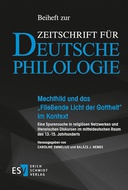Explore

Mechthild und das "Fließende Licht der Gottheit" im Kontext
Caroline Emmelius and Balázs J. Nemes
2019
0 Ungluers have
Faved this Work
Login to Fave
Über die Umstände von Entstehung und Rezeption eines der wichtigsten Texte der deutschen Mystik, Mechthilds „Fließendes Licht der Gottheit“ und seine lateinische Übersetzung, gab es bislang vor allem Mutmaßungen und Legendenbildungen. Diese waren insbesondere der schwierigen Überlieferung der beiden Fassungen geschuldet. Neuere Handschriftenfunde der letzten Jahre erlauben inzwischen präzisere Verortungen der beiden Texte und der Verfasserin Mechthild (von Magdeburg) im mitteldeutschen Raum. Der Band setzt hier an: Er leistet zum einen eine kritische Sichtung der gängigen Narrative, zum anderen bietet er aus unterschiedlichen disziplinären Perspektiven Ansätze zur Korrektur bisher gültiger Annahmen. Diese betreffen u.a. Mechthilds Status als (Laien-)Schwester im Kloster, die adligen und geistlichen Netzwerke, in denen das Kloster Helfta im 13. Jahrhundert steht; sie betreffen die intertextuellen Bezüge zwischen dem „Fließenden Licht“ und der zeitgenössischen geistlichen und weltlichen Literatur, den Sprachstand des „Fließenden Lichts“ sowie die spätmittelalterliche Rezeption der Helftaer Texte in mitteldeutschen Klöstern. Der Band stellt das „Fließende Licht“ und seine Rezeption damit erstmals in den Mittelpunkt der interdisziplinären Forschungsdiskussion.The circumstances of the origin and reception of one of the most important texts of German mysticism, Mechthild’s “Fließendes Licht der Gottheit” and its Latin translation, have so far been mainly the subject of speculation and legend. This was due to the difficult tradition of the two versions. However, the discovery of unknown manuscripts in recent years allow a more precise localisation of the two texts and the author Mechthild (of Magdeburg) in the area of central Germany. This is the starting point of the volume: On the one hand, it provides a critical review of the common narratives, and on the other hand, it offers approaches from different disciplinary perspectives to correct previously valid assumptions. These concern for example Mechthild’s status as a (lay) sister in a monastery, the aristocratic and spiritual networks in which Helfta Monastery was located in the 13th century; they concern the intertextual relationships between the “Fließende Licht” and contemporary spiritual and secular literature, the linguistic status of the “Fließende Licht” and the late medieval reception of the Helfta texts in central German monasteries. This volume thus places “Fließendendes Licht” and its reception at the centre of the interdisciplinary research discussion for the first time.
This book is included in DOAB.
Why read this book? Have your say.
You must be logged in to comment.
Rights Information
Are you the author or publisher of this work? If so, you can claim it as yours by registering as an Unglue.it rights holder.Downloads
This work has been downloaded 107 times via unglue.it ebook links.
- 107 - pdf (CC BY-NC-ND) at Unglue.it.
Keywords
- 13. Jahrhundert
- deutschsprachig
- Handschrift
- Klosterliteratur
- Legenden
- Mittelalter
- Mittelalter, deutschsprachig
- mitteldeutsche Sprache
- mystik
Editions

